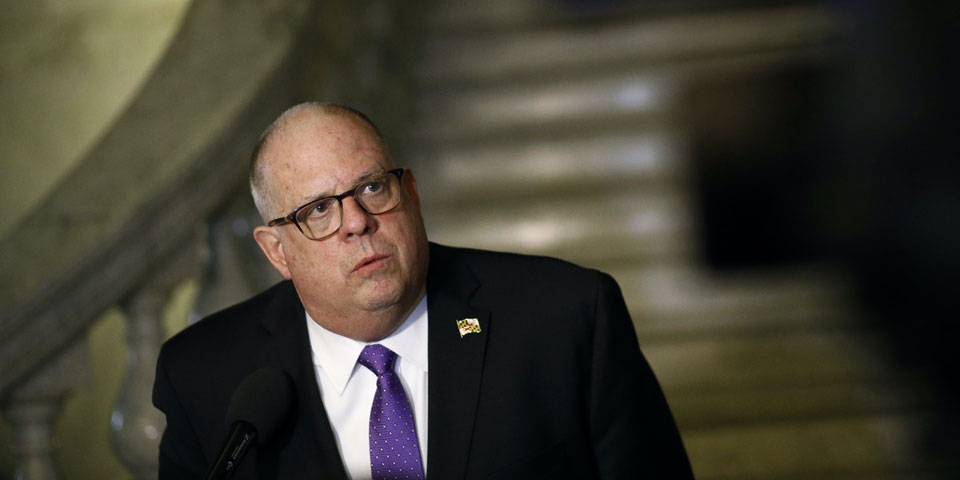
ANNAPOLIS, Md.—A school reopening disagreement has broken out in Maryland, openly pitting teachers unions and the state’s big “blue” counties, Montgomery and Prince George’s, plus “blue” Baltimore City and “purple” Baltimore County, against top state officials. But a sample of “red” counties in Maryland’s east and west show they plan to stall reopening, too.
And Gov. Larry Hogan (R), praised until now for his handling of the coronavirus’s impact on the otherwise deep-blue Old Line State, set it off with a school reopening plan which state teachers’ unions and the PTA thought went too far, too fast.
But Hogan also left reopening up to individual counties. The big county school districts in the middle of the state, which educate most of Maryland’s students, didn’t think Hogan’s 13-point requirements for reopening were good enough. Instead, they opted to stall and start the year with virtual distance teaching. The big districts will reconsider in November.
“Red” counties in the Eastern Shore and the far western mountains agreed to the 13 points but then balked on timing, as a check of three of Maryland’s other 20 counties—Wicomico on the Eastern Shore, Frederick, which straddles the D.C. exurbs and the mountains, and far western Garrett—showed.
The Maryland disagreement thus slightly differs from the national pattern. Republican-run states, at the urging and demand of GOP President Donald Trump, rushed to reopen bars, beaches, theaters, restaurants, shopping malls, stores and schools too soon, despite the galloping coronavirus pandemic, and despite rising numbers of infected youngsters.
The results have been skyrocketing caseloads and death counts in states such as Florida, Arizona, Georgia, Texas and Oklahoma. Meanwhile “blue state” New York, site of the largest initial outbreak, curbed the virus so successfully that community spread virtually halted and New York City’s school district, by far the largest in the U.S., cautiously reopened.
With that as background, Hogan and State School Superintendent Cheryl Bost, a Hogan appointee, promulgated their 13-point plan to reopen the physical school buildings. Many districts, including Garrett, said OK. But just a week before schools were to start, Bost and the state school board added a new requirement: Massive rescheduling.
In a joint letter to the state Board of Education, the Maryland State Teachers Association/NEA, the Maryland Federation of Teachers and the Maryland PTAs protested. The Baltimore Teachers Union/AFT said “no,” too.
All emphasized there is still insufficient personal protective equipment (PPE) for teachers and staff, inadequate testing of everyone for the coronavirus, and not enough money or space to institute the social controls, such as spacing students’ desks six feet apart, to prevent “community spread” of the virus within classrooms.
The rescheduling scheme would only make matters worse, they said, in an accompanying statement on August 31. It “completely demoralized” all the teachers and administrators who worked hard to meet the original requirements.
“Have any of you ever tried to set a school schedule for 300 students and educators? What about 1,000 or 2,000 students? It takes weeks and sometimes months to figure out what class each student should be in or the individual assistance they need at any given time of the day. It takes countless hours to communicate these changes to families and respond to their concerns,” they wrote in their letter to the board.
“Demanding schools redo nearly all of their scheduling” in 20 days or fewer “diverts a tremendous amount of time while at the same time administrators are trying to juggle a virtual start and transitioning to a hybrid model” of computer and virtual learning in the first weeks and in-school classes, if possible, afterwards.
Not only that, but schools, teachers and administrators had to make sure students have laptops or tablets, schools have working WiFi, meals will be available—which means cafeteria workers must prepare them—and the schools have enough PPE, follow social distancing and figure out how to teach students whose parents decide to keep them at home the whole year.
“There is a lot going on in planning for instruction and learning to take place no previous administrator or educator ever encountered. Getting it wrong could have dire consequences.”
The three groups signing the joint letter reminded Hogan, Bost and the school board they had offered their own, much more rigorous reopening plan, in mid-July. Any physical reopening, they said, should be delayed until, at the earliest, the start of the second semester, around Thanksgiving.
The three big county school districts apparently paid attention and postponed physical reopening until November at the earliest. Baltimore County posted a one-sentence declaration at the top of its website, in big navy blue boldfaced type: “Schools will be 100% virtual from September 8, 2020–January 29, 2021.”
“We are still moving forward with virtual reopening, beginning September 8, but we will immediately begin to look at our plan to incorporate already created hybrid models that include a phased-in plan for small groups of students to return to our buildings,” Superintendent Darryl Williams added. “As we implement this small-group phased-in approach and are sure students and staff are safe, we will continue to evaluate the implementation and add groups of students until all have returned to school. This will take time.”
But so did the other counties, even Garrett which, based on statistical data alone, could physically reopen right now. It’s had 63 coronavirus deaths since the pandemic was officially proclaimed on March 13. At 29, 233 residents, it’s Maryland’s third-smallest county.
“There are many logistical issues that need to be addressed before the school system can return to full in-person learning,” Superintendent Barbara Baker wrote county residents on August 30. So Garrett will stick with virtual learning, too, for now.
“We must transport students to & from school and educate students in classrooms while adhering to the physical distancing guidelines provided by the governor. Furthermore, if there is a sudden increase in either the case rate or positivity rate throughout the county, a discussion between local health and education officials will be necessary to determine if changes are needed to prevent the spread of the virus,” she explained.










